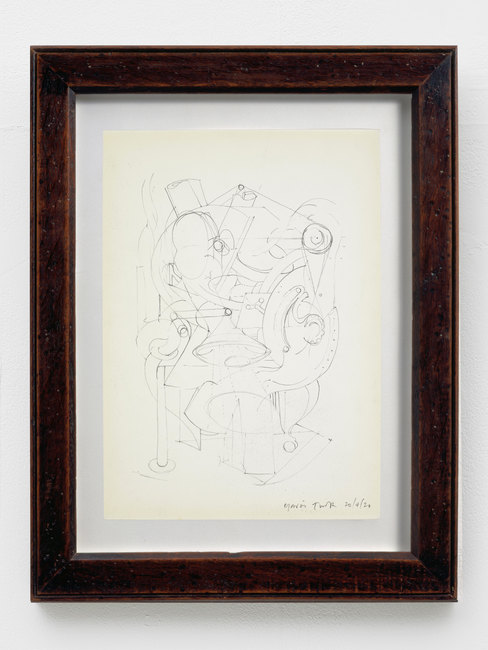AboutEssays1991Plato's Cave
The allegory of Plato’s Cave, as told by the Greek philosopher in The Republic (approx 360 BC) goes right to the heart of human existence by seeking to answer the question: what is truth? The story of the philosopher-poet-king’s ascent from the ignorant pit of humanity to the sun, followed by his subsequent return to share the knowledge, it deals with ideas about consciousness, perception, perspective, representation and truth and has influenced thought in philosophy, psychology, art, sociology, science and education.
The story begins with a cave in which man is imprisoned. His neck and legs are chained in a way that he cannot move while he can only see what is before him. Behind the chained prisoners, a fire burns providing a degree of light with which they are able to see. On a shelf in the cave between the prisoners and the fire, a series of marionettes in the shape of animals and plants are moved by an unseen carrier. The shadows of the marionettes are cast by the fire onto the wall directly ahead of the prisoners in order to create a series of moving images in the manner of a primitive cinema.
Unable to see anything else, the prisoners take these shadows for real and play games naming them as they appear on the wall, judging each other on their speed and skill in identification. They also believe the echoes from the unseen carriers to be the speech of the shadows. A rare prisoner manages to break from his chains. Standing up and turning around, he is able to see past the fire and the puppets to an opening in the cave, through which he can glimpse the sun. Accustomed to darkness and shadows, the released man finds the experience painful. But despite this, he is compelled to climb out of the cave towards the light.
His journey is a difficult and tortuous one but the prisoner would rather suffer it than remain in the misery of the cave. Coming into the sunlight outside the cave, he is able to see plants and animals as they really are and understands that what he had formerly taken to be real as mere shadows of representations. Finally turning directly towards the sun, the prisoner perceives the sun as the ultimate giver of life and enters into a state of total understanding.
Once enlightened, he can’t help but return to the cave to free his fellow inmates. However some resist enlightenment and taunt the returned prisoner because, having become so used to sunlight, he performs badly at the game of identifying shapes. Not only that, but the other prisoners threaten to punish anyone who attempts the ascent with death.
Central to the allegory of the cave, is Plato’s belief that an absolute truth which exists outside of man underlies all things, with the sun as a metaphor for Good and man’s ascent, a rigorous philosophical and intellectual journey to enlightenment. An undemocratic elitist, Plato held this journey to be a laborious and difficult one, which only philosophers, poets or kings were capable of. The completion of this journey, in turn would qualify them to be leaders of men.
Wrote Plato in The Republic: “But whether true or false, my opinion is that in the world of knowledge the idea of good appears last of all, and is seen only with an effort; and, when seen, is also inferred to be the universal author of all things beautiful and right, parent of light and of the lord of light in this visible world.”
At the heart of Plato’s allegory is his belief that art is a false illusion and artists, myth makers who obfuscate the truth. Instead, truth is to be revealed through open-minded reasoning which Plato explores through his Theory of Forms. According to this theory, we don’t understand a circle by looking a wheel but, like Pythagoras and Euclid, by thinking about the ideal circle. In just the same way a geometer imagines the true form of the circle, therefore a philosopher might imagine the true form of Good which is timeless and impervious to subjective interpretation or change.
The allegory of the cave went on to influence Renée Descartes, who, like Plato, believed the senses to be misleading and who rationalised his existence with the proposal “I think therefore I am.” However, the Empiricist thought of John Locke and David Hume, on the other hand rejected the allegory of the cave by supposing that some (or all) knowledge does comes from the senses.
Christianity has taken Plato’s Cave as a metaphor for Christian truth, with God as the sun and moral authority given to those who have seen The Light. As mere mortals, the true mystery of God will never be fully revealed to us but we are able to see “through a glass darkly.”
The Romantics – notably Wordsworth, Coleridge and Blake – chose to interpret Plato’s Cave as a visionary approach not to any Heavenly kingdom but to this. In this light, art does not obfuscate, it illuminates while eternity is revealed not through any abstract Platonic ideal but the infinity of “a grain of sand”, instead.
In the 21st Century, where increasingly we experience the real through the prism of TV, the modern relevance of the cave can be taken as an allegory not so much for deception by art as deception by the media. “Humankind lingers unregenerately in Plato’s Cave, still revelling, its age-old habit, in mere images of the truth,” wrote Susan Sontag in “On Photography” of the gap between the photographic enterprise and understanding the real. “Photography,” she went on to say, “Implies that we know about the world if we accept it as the camera records it. But this is the opposite of understanding, which starts from not accepting the world as it looks.”
Further Reading
“The Republic” Plato, “Essence of Truth: On Plato’s Parable Of The Cave” Martin Heidegger, “On Photography” Susan Sontag, “Consciousness Explained” Daniel Dennett






